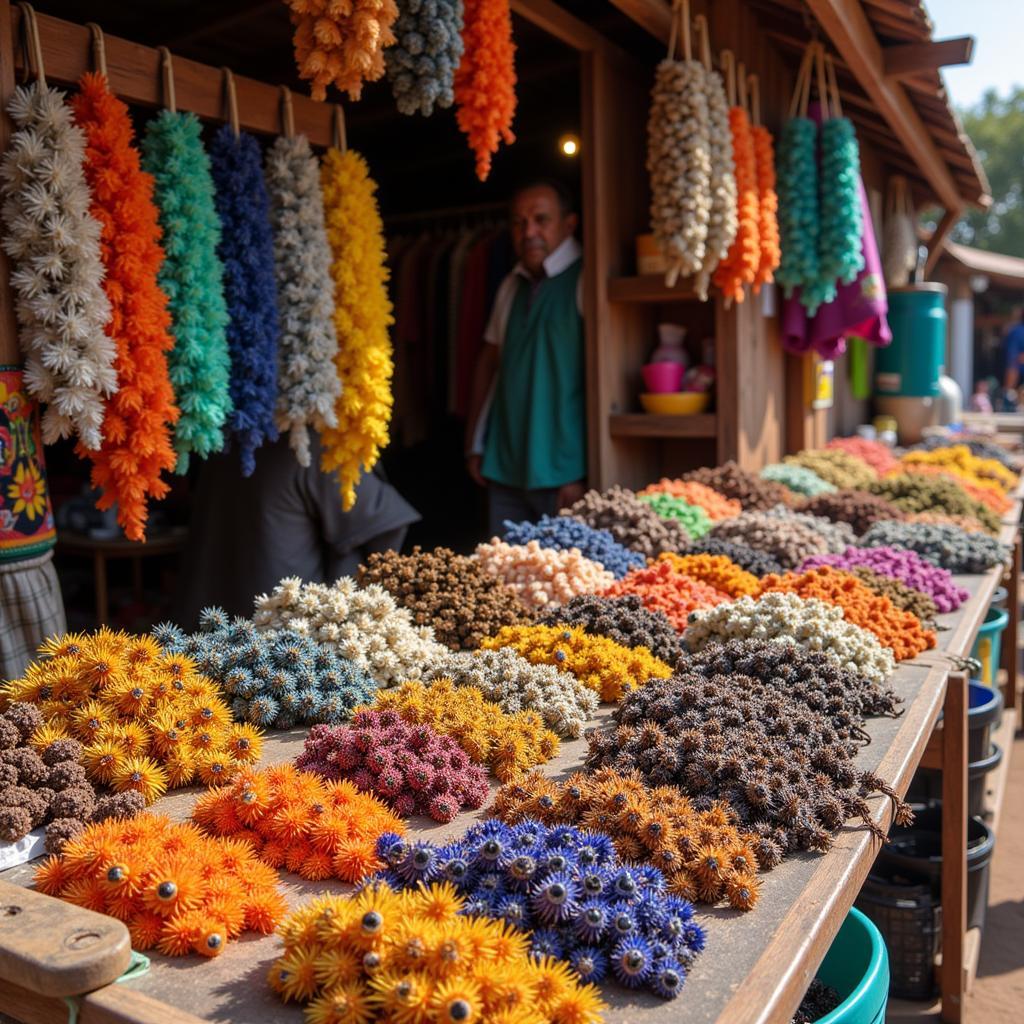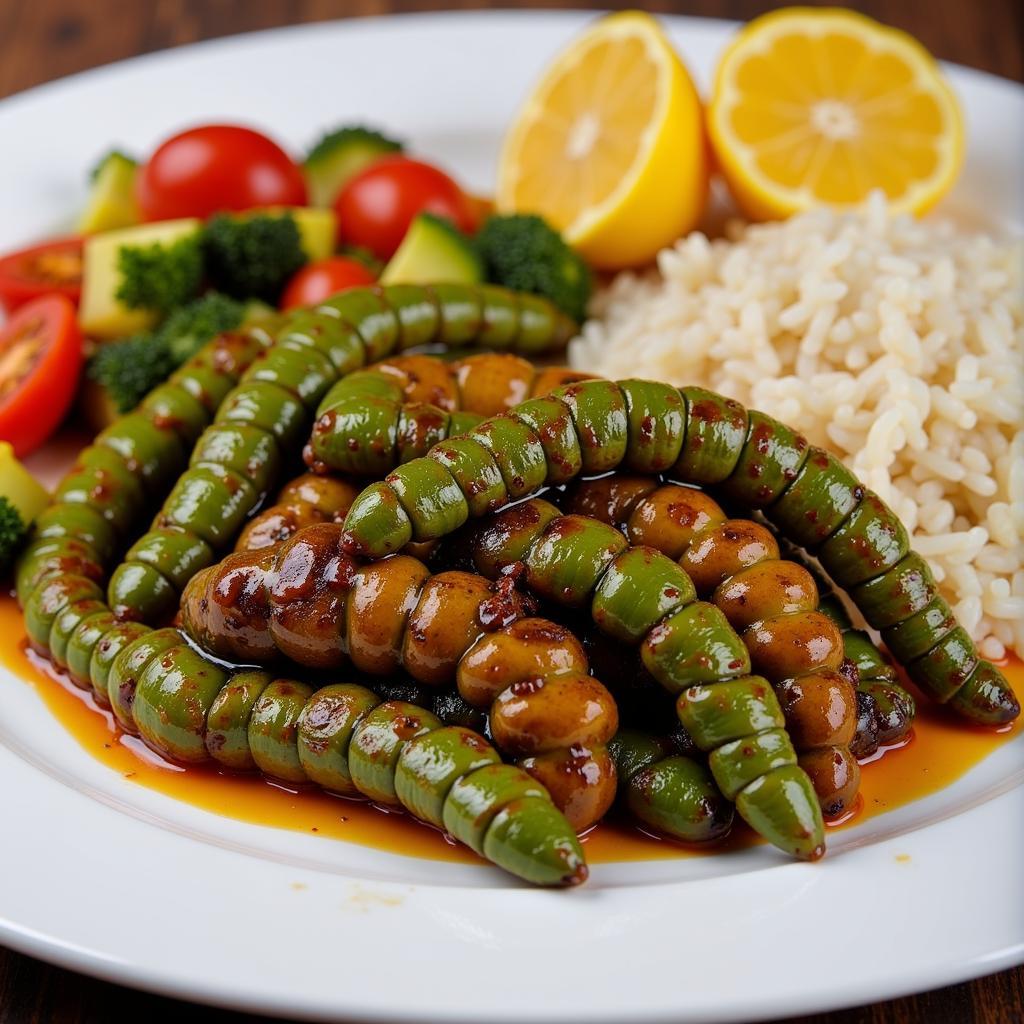Edible African Caterpillars: A Nutritious Delicacy
African Caterpillar Food might sound unusual to some, but across the continent, these crawly critters are a celebrated delicacy. Providing essential protein and nutrients, edible caterpillars play a significant role in local diets and economies. Let’s explore the fascinating world of African caterpillars and discover why they are more than just a snack.
A Diverse Menu: Unveiling the Popular African Caterpillars
Africa boasts a variety of edible caterpillar species, each with unique flavors and textures. Here are some of the most popular:
- Mopane Caterpillar: Found primarily in Southern Africa, the Mopane caterpillar is a true icon. Named after the Mopane tree it feasts on, this plump caterpillar is often dried or smoked for preservation and boasts a nutty, earthy flavor.
- Shea Caterpillar: Prized in West Africa, the Shea caterpillar derives its name from the Shea trees it inhabits. It offers a delicate, almost buttery taste and is enjoyed fried, roasted, or incorporated into stews.
- African Palm Weevil Larvae: Considered a delicacy in Central Africa, these plump grubs reside within palm trees. Their rich, fatty flavor profile resembles bacon, making them a sought-after treat.
 African Caterpillar Market
African Caterpillar Market
Nutritional Powerhouse: Why Caterpillars Matter
Beyond their unique flavors, African caterpillars are packed with nutrients. They offer a significant source of:
- Protein: Essential for growth and repair, caterpillars often provide a more accessible protein source than traditional meat.
- Iron: Combating iron deficiency and anemia, caterpillars contribute to healthy blood and overall vitality.
- Zinc: Supporting immune function and wound healing, zinc is abundant in many edible caterpillar species.
- Vitamins and Minerals: Caterpillars contain essential vitamins and minerals like riboflavin and thiamine, vital for energy production and overall health.
From Forest to Table: Harvesting and Preparing Caterpillars
Harvesting caterpillars is a seasonal activity, often involving women and children who carefully collect them from trees and vegetation. Once gathered, caterpillars are typically:
- Degutted: The digestive tract is removed to enhance flavor and prevent spoilage.
- Boiled: A quick boil cleanses the caterpillars and prepares them for further cooking or preservation.
- Sun-dried or Smoked: These methods extend shelf life while intensifying flavor.
A Culinary Adventure: Savoring the Flavors
African caterpillars are incredibly versatile in the kitchen. They can be:
- Fried: A popular method, frying yields crispy caterpillars bursting with flavor.
- Roasted: Roasting brings out the nutty and smoky notes of the caterpillars.
- Stewed: Added to stews and sauces, caterpillars impart a unique depth and richness to the dish.
- Eaten as a Snack: Dried caterpillars are enjoyed as a crunchy and flavorful snack.
Sustainable and Ethical Considerations
As with any food source, sustainability and ethical harvesting practices are crucial. Supporting initiatives that promote:
- Responsible Harvesting: Ensuring populations remain healthy and balanced.
- Fair Trade Practices: Providing fair wages and working conditions for harvesters.
 African Caterpillar Dish
African Caterpillar Dish
Conclusion
African caterpillar food offers a glimpse into the rich tapestry of culture and sustainable living on the continent. These nutritious and delicious insects play a vital role in local communities, showcasing the ingenuity and resourcefulness of traditional food practices. So, the next time you’re feeling adventurous, why not explore the fascinating world of edible African caterpillars? You might be surprised at what you discover.
FAQs about African Caterpillar Food
1. Are all caterpillars in Africa edible?
No, only specific species are edible. It’s crucial to rely on local knowledge and expertise to identify safe and edible varieties.
2. What do African caterpillars taste like?
The flavor varies depending on the species, but common descriptions include nutty, earthy, buttery, and even smoky or meaty.
3. Where can I try African caterpillars?
You might find them at specialized African restaurants or markets. In certain regions of Africa, they are a common street food.
4. Are there any health risks associated with eating caterpillars?
As with any food, allergies are possible. It’s essential to cook caterpillars thoroughly and practice food safety measures.
5. Are African caterpillars a sustainable food source?
When harvested responsibly, caterpillars offer a sustainable source of protein and nutrients.
You might also be interested in:
For more insights into the fascinating world of African wildlife, check out these articles:
- African Desert Biome Animals
- Difference Between Indian Elephants and African Elephants
- African King Cobra
Need more information or assistance? Don’t hesitate to reach out!
Contact us at:
Phone Number: +255768904061
Email: [email protected]
Address: Mbarali DC Mawindi, Kangaga, Tanzania.
Our customer support team is available 24/7 to assist you.

